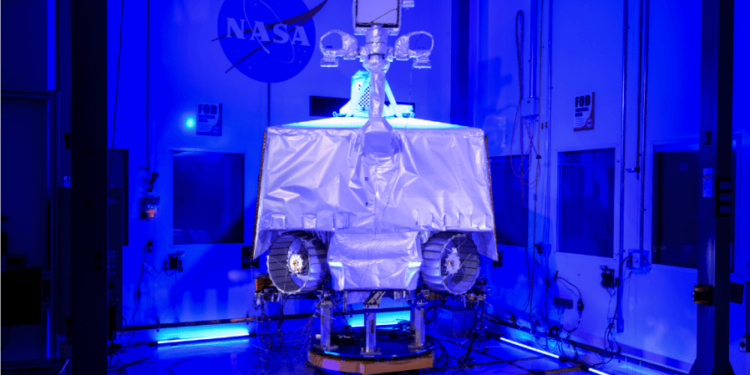
Last year, NASA canceled the VIPER (“Volatiles Investigating Polar Exploration Rover”) in a move that scandalized proponents of a return to the moon. The space agency was just $84 million short of completing the mission when it pulled the plug. VIPER had been slated to go to the moon on board an Astrobotic Griffin lander.
Then, the space agency asked for ideas from the private sector for delivering the water-hunting robot to the lunar surface commercially. A Texas company called Intuitive Machines offered a detailed plan.
Now, with a change of presidents and a new, reformist NASA administrator nominated and about to go through the confirmation process, the space agency has reiterated its desire to save the VIPER with a commercial partnership. It is requesting more comprehensive plans to fly VIPER to the moon with a deadline of Feb. 20. NASA will make a final decision in the summer.
The selected company would be required to accept VIPER as is and not dismantle the rover and incorporate its instruments into another vehicle. It would bear the cost of transporting it to the lunar surface and operating it.
VIPER’s mission is to trundle about the lunar south pole searching for signs of water. Scientists have known for decades the water ice resides in the permanently shadowed craters of the lunar poles, deposited over billions of years of comet impacts. VIPER should be able to pinpoint where the ice is located and in what amounts.
No mention as yet has been made about when VIPER might go to the moon. The Intuitive Machines proposal suggests that the rover would go on an in-development Nova-D lander that would be ready in 2027. That is also the year NASA plans to land the first people on the moon in 55 years as part of the Artemis III mission.
The fact that NASA is going ahead with VIPER and is trying to arrange for a commercial partner for the lunar rover has broader implications for American space policy as the new Trump administration puts its own stamp on future space exploration.
Of all the resources that can be found on the moon, water is the most important. It can be chemically split into oxygen and hydrogen and made into rocket fuel. Water can also be used to drink and in agriculture.
However, lunar water is not important unless people are going to the moon to live and work there. Recent statements by President Trump and SpaceX CEO Elon Musk hinted that the U.S. might bypass the moon and send astronauts directly to Mars.
If Americans are not returning to the moon to establish a base, VIPER would be unnecessary. Since VIPER is going to the moon, it logically follows that the moon is still on for America’s exploration plans.
Another hint that we’re still going back to the moon was tucked into a White House statement during a visit by the Japanese prime minister.
“The United States and Japan intend to continue their strong partnership in civil space and on aeronautics, science and human exploration, including on the upcoming Crew-10 mission to the International Space Station that includes U.S. and Japanese astronauts as well as lunar surface exploration on future Artemis missions.”
Even so, it would be a good idea for someone, from the White House or NASA, to specifically state that America is not going to yield the moon to the Chinese. Such a statement would remove a lot of doubt and uncertainty.
Astrobotic has moved on from the VIPER fiasco. The company recently announced that instead of VIPER it will deliver the FLEX Lunar Innovation Platform rover to the south pole of the moon as early as the end of 2025. A company called Venturi Astrolab built that rover, which is about the same size and mass as VIPER. Neither company has revealed the terms of the agreement.
Astrobotic famously attempted to send its Peregrine lander to the moon a year ago, an endeavor that ultimately failed.
The story of VIPER, with its twists and turns, proves the wisdom of NASA’s turn to the commercial sector for partnerships that started during the George W. Bush administration. Under the old way of doing things, NASA had to ask Congress for more money or it would be out of luck. Now commercial companies will not only have saved VIPER but will have added a new robotic lunar explorer.
Mark R. Whittington is the author of “Why is It So Hard to Go Back to the Moon?” as well as “The Moon, Mars and Beyond,” and, most recently, “Why is America Going Back to the Moon?” He blogs at Curmudgeons Corner.






